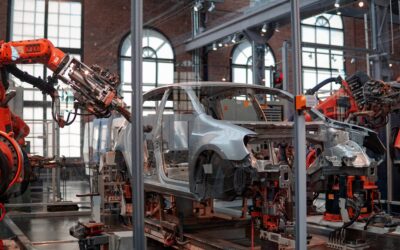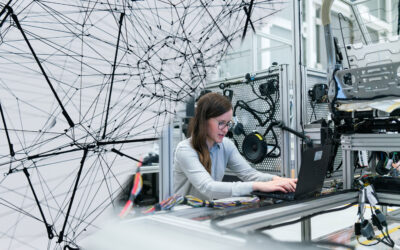In his capacity as the Technical Product Manager at MVTec Software GmbH, Mario Bohnacker has been responsible for the technical enhancement of the standard machine vision software HALCON. His duties include identifying technologies that are relevant for future developments as well as for customers and turning them into product innovations. Furthermore, he also directs the further development of MVTec HALCON in order to deliver maximum customer benefits.
More than almost any other industry, the food industry depends on safe and high-quality products. Machine vision accompanies and optimizes the entire value chain – especially quality assurance. With the machine vision technology Anomaly Detection, which is used in MVTec’s standard software HALCON, defects can be detected more precisely, which contributes to the continuous automation of inspection processes. Food producers can thus increase their productivity and save costs.
Machine vision is now unfolding its benefits in numerous industrial sectors. The technology is also increasingly being used in food production. Here, machine vision supports the entire workflow through the targeted and automated detection of objects – from production and quality assurance to logistics processes.
A wide range of application scenarios are conceivable in the food industry: For example, a wide variety of baked goods such as rolls or pretzel sticks that touch each other on the conveyor belt can be reliably separated and precisely counted with 3D image processing features before packaging. Dough pieces of various types can also be accurately detected using machine vision in order to automatically cut them in at the correct position. This prevents uncontrolled bursting in the wrong place.
Precise portioning of meat cuts
The technology also provides valuable support in the meat industry – for example, in the automated portioning of schnitzels and steaks. Here, machine vision captures the entire meat pieces, i.e. in a 360-degree radius, with several 3D recording devices seamlessly. This generates point clouds and merges them into a uniform, three-dimensional object. This way, the meat pieces can be cut extremely precisely and without major losses. This allows saving large quantities of meat mass and thus saving costs.
Not only machine vision does enable products in the food industry to be reliably detected for safe processing. Moreover, the technology supports defect inspection: anomalies of various kinds can be identified and localized very precisely. The image processing algorithms can soundly evaluate a wide range of quality features and reliably detect corresponding defects. Machine vision is therefore indispensable for automated inspection processes in the quality assurance of food producers.
Automating high volume inspection
This is also made clear from another example from the baking industry: the degree of browning of hamburger buns, for example, can be precisely determined using 2D color analysis. If, for instance, the buns have been baked too long, this can be clearly seen from the color values on the surface. As a result, the overly browned buns can be automatically sorted out before they reach the retail market. The machine vision algorithms work at high speed and detect objects or defects within milliseconds. In this way, the food industry can automate and accelerate identification and inspection processes, even for high volumes.
Modern methods based on artificial intelligence (AI) are of central importance in object recognition and defect inspection. These are already an integral part of modern image processing software. Deep learning technologies in particular play an important role. This allows detection rates to be significantly improved by means of comprehensive training. In this process, the software learns typical characteristics and peculiarities of the objects to be recognized through the detailed evaluation of large quantities of digital image data. In this way, the objects can be precisely classified, i.e. assigned to a specific class – for example “apple” or “pear”. Even the most varied deviations from the target state can be assigned to a specific defect class. Artificial intelligence does not only increase detection rates through training. Also, the effort required for the complete inspection process is significantly reduced.
Minimize effort for defect detection
Normally, so-called “bad images” are required for training. These are characterized by the fact that the respective defect is directly recognizable in the image. But particularly in the food production, countless different manifestations of defects are conceivable. It is therefore necessary to record a high number of training images. This means that at least 150 bad images are required for each type of defect. However, this causes a very high effort, which is usually hardly profitable for companies. MVTec offers a practical solution to this problem: The machine vision standard software HALCON contains a technology that no longer requires any bad images for training. Thanks to the Anomaly Detection feature, as few as 20 to a maximum of 100 images of the object in error-free condition are sufficient. Food producers are thus able to significantly reduce the amount of training required.

This advantage is clearly illustrated by an example from cookie production: Anomaly detection technology can be used to automatically inspect the chocolate icing on cookies. Here, the software algorithms use the brightness structure of the surface to detect whether the chocolate has been correctly applied to the baked product. Thanks to anomaly detection, only images showing correctly glazed cookies are required for training. If bad images were required here, the effort for generating them could hardly be made. After all, there are countless different possibilities of incorrectly applied chocolate coating.
Conclusion
Machine vision systems can also be used in the food industry to optimize processes along the entire value chain. Quality assurance in particular benefits from this. For example, modern, AI-based technologies such as Anomaly Detection help to significantly improve defect detection rates and reduce the effort required for training. This takes the efficiency of inspection processes to a whole new level.
About MVTec Software GmbH
MVTec is a leading manufacturer of standard software for machine vision. MVTec products are used in all demanding areas of imaging: semiconductor industry, surface inspection, automatic optical inspection systems, quality control, metrology, as well as medicine and surveillance. By providing modern technologies such as 3D vision, deep learning, and embedded vision, software by MVTec also enables new automation solutions for the Industrial Internet of Things aka Industry 4.0. With locations in Germany, the USA, and China, as well as an established network of international distributors, MVTec is represented in more than 35 countries worldwide.
Use neural networks and advanced object detection for visual quality assurance of metallic & complex workpieces



